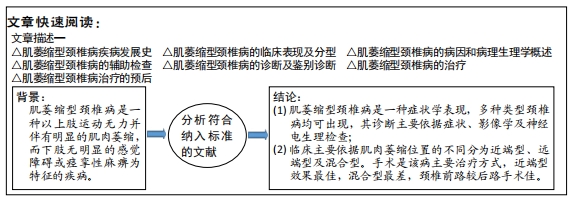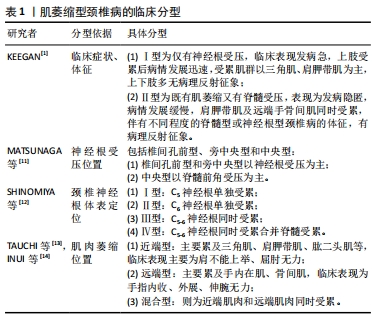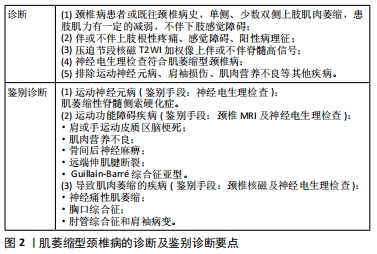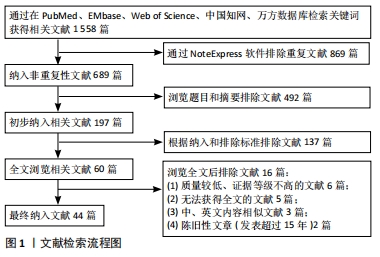[1] KEEGAN JJ. The cause of dissociated motor loss in the upper extremity with cervical spondylosis. J Neurosurg. 1965;23(5):528-536.
[2] BRAIN WR, NORTHFIELD D, WILKINSON M. The neurological manifestations of cervical spondylosis. Brain. 1952;75(2):187-225.
[3] CRANDALL PH, BATZDORF U. Cervical spondylotic myelopathy. J Neurosurg. 1966;25(1):57-66.
[4] SOBUE I, KATO H, YANAGI T. Clinical characteristics and classification of cervical spondylotic myelopathy. Rinsho Seikei-gaku.1975;10:999-1006 (in Japanese).
[5] 王洪立,吕飞舟,马晓生,等.颈椎病伴上肢近端肌萎缩的临床诊断与手术治疗[J].中华骨科杂志,2017,37(4):210-216.
[6] GEBERE-MICHAEL SG, JOHNSTON JC, METAFERIA GZ, et al. Bilaterally symmetric cervical spondylotic amyotrophy: a novel presentation and review of the literature. J Neurol Sci. 2010;290(1-2):142-145.
[7] SONOO M. Cervical Spondylotic Amyotrophy. Brain Nerve. 2016;68(5):509-519.
[8] JIANG SD, JIANG LS, DAI LY. Cervical spondylotic amyotrophy. Eur Spine J. 2011;20(3):351-357.
[9] LI T, SHI G, SHI L, et al. Clinical features and long-term surgical outcomes of patients with cervical spondylotic amyotrophy. World Neurosurg. 2019; 121:e172-e180.
[10] KAMEYAMA T, ANDO T, YANAGI T, et al. Cervical spondylotic amyotrophy. Magnetic resonance imaging demonstration of intrinsic cord pathology. Spine (Phila Pa 1976). 1998;23(4):448-452.
[11] MATSUNAGA S, SAKOU T, IMAMURA T, et al. Dissociated motor loss in the upper extremities. Clinical features and pathophysiology. Spine (Phila Pa 1976). 1993;18(14):1964-1967.
[12] SHINOMIYA K, KOMORI H, MATSUOKA T, et al. Neuroradiologic and electrophysiologic assessment of cervical spondylotic amyotrophy. Spine (Phila Pa 1976). 1994;19(1):21-25.
[13] TAUCHI R, IMAGAMA S, INOH H, et al. Risk factors for a poor outcome following surgical treatment of cervical spondylotic amyotrophy: a multicenter study. Eur Spine J. 2013;22(1):156-161.
[14] INUI Y, MIYAMOTO H, SUMI M, et al. Clinical outcomes and predictive factors relating to prognosis of conservative and surgical treatments for cervical spondylotic amyotrophy. Spine (Phila Pa 1976). 2011;36(10):794-799.
[15] IMAJO Y, KATO Y, KANCHIKU T, et al. Pathology and prognosis of proximal-type cervical spondylotic amyotrophy: new assessment using compound muscle action potentials of deltoid and biceps brachii muscles. Spine (Phila Pa 1976). 2011;36(7):E476-E481.
[16] TOFUKU K, KOGA H, YONE K, et al. Conservative treatment with hyperbaric oxygen therapy for cervical spondylotic amyotrophy. Spinal Cord. 2011;49(6):749-753.
[17] WANG HL, LI HC, JIANG JY, et al. Evaluation of characteristics and surgical outcomes in cervical spondylotic amyotrophy. Indian J Orthop. 2014;48(5):511-517.
[18] TAKEBAYASHI T, YOSHIMOTO M, IDA K, et al. Minimum invasive posterior decompression for cervical spondylotic amyotrophy. J Orthop Sci. 2013; 18(2):205-207.
[19] FUJIWARA Y, TANAKA N, FUJIMOTO Y, et al. Surgical outcome of posterior decompression for cervical spondylosis with unilateral upper extremity amyotrophy. Spine (Phila Pa 1976). 2006;31(20):E728-E732.
[20] TOLEDANO M, BARTLESON JD. Cervical spondylotic myelopathy. Neurol Clin. 2013;31(1):287‑305.
[21] TAKAHASHI T, HANAKITA J, MINAMI M, et al. Cervical spondylotic amyotrophy: case series and review of the literature. Neurospine. 2019;16(3):579-588.
[22] STĘPIEŃ A, MAZURKIEWICZ Ł, MAŚLANKO K, et al. Cervical rotation, chest deformity and pelvic obliquity in patients with spinal muscular atrophy. BMC Musculoskelet Disord. 2020;21(1):726.
[23] ZHENG C, JIN X, ZHU Y, et al. Repetitive nerve stimulation as a diagnostic aid for distinguishing cervical spondylotic amyotrophy from amyotrophic lateral sclerosis. Eur Spine J. 2017;26(7):1929-1936.
[24] 冯小宁,叶霞,马迅,等.平山病临床相关研究的进展[J].中华骨科杂志, 2019,39(8):518-524.
[25] 复旦大学附属华山医院骨科,北京大学第三医院骨科,《中华骨科杂志》编辑部,等.平山病临床诊疗规范国际指南[J].中华骨科杂志, 2019,39(8):452-457.
[26] HIRAYAMA K. Juvenile muscular atrophy of unilateral upper extremity (Hirayama disease) half-century progress and establishment since its discovery. Brain Nerve. 2008;60(1):17-29.
[27] 王洪光.3.0T磁共振多平面成像对肩峰下撞击综合征的临床诊断影响分析[J].中国医疗器械信息,2021,27(4):137-138.
[28] GERVASIO O, GAMBARDELLA G, ZACCONE C, et al. Simple decompression versus anterior submuscular transposition of the ulnar nerve in severe cubital tunnel syndrome: a prospective randomized study. Neurosurgery. 2005;56(1):108-117.
[29] 孟亚轲,张健,杨勇,等.肌萎缩型颈椎病13例的诊治观察[J].中华医学杂志, 2017,97(17):1320-1323.
[30] LIU T, XU W, CHENG T, et al. Anterior versus posterior surgery for multilevel cervical myelopathy, which one is better? A systematic review. Eur Spine J. 2011;20(2):224-235.
[31] YE X, SUN Y. Advances in research of cervical spondylotic amyotrophy. Zhonghua Wai Ke Za Zhi. 2019;57(9):717-720.
[32] YAMADA T, YOSHII T, USHIO S, et al. Surgical outcomes for distal-type cervical spondylotic amyotrophy: a multicenter retrospective analysis of 43 cases. Eur Spine J. 2019;28(10):2333-2341.
[33] 关海山,李承罡,史洁,等.前路减压融合术与后路单开门椎管扩大成形术治疗多节段脊髓型颈椎病的中期随访研究[J].中华骨科杂志, 2019,39(17):1044-1052.
[34] SRINIVASA RAO NV, RAJSHEKHAR V. Distal-type cervical spondylotic amyotrophy: incidence and outcome after central corpectomy. J Neurosurg Spine. 2009;10(4):374-379.
[35] BAXTER C, MILLER TA, ROSS DC, et al. Treatment of cervical spondylotic amyotrophy with nerve transfers. J Hand Surg Am. 2018;43(7):684.e1-684.e4.
[36] UCHIDA K, NAKAJIMA H, SATO R, et al. Multivariate analysis of the neurological outcome of surgery for cervical compressive myelopathy. J Orthop Sci. 2005;10(6):564-573.
[37] 孟亚轲,张健,杨勇,等.肌萎缩型颈椎病13例的诊治观察[J].中华医学杂志, 2017,97(17):1320-1323.
[38] 钟卓霖,胡建华,翟吉良,等.伴肌萎缩颈椎病的手术治疗效果[J].中华骨与关节外科杂志,2015,8(3):209-213.
[39] UCHIDA K, NAKAJIMA H, YAYAMA T, et al. Anterior and posterior decompressive surgery for progressive amyotrophy associated with cervical spondylosis: a retrospective study of 51 patients. J Neurosurg Spine. 2009;11(3):330-337.
[40] LIU X, MIN S, ZHANG H, et al. Anterior corpectomy versus posterior laminoplasty for multilevel cervical myelopathy: a systematic review and meta-analysis. Eur Spine J. 2014;23(2):362-372.
[41] LU CB, MA ZS, HU JB, et al. Evaluation of anterior decompression surgical outcomes of proximal-type cervical spondylotic amyotrophy: a retrospective study. Orthop Surg. 2020;12(3):734-740.
[42] IMAJO Y, NISHIDA N, FUNABA M, et al. Preoperative factors that predict fair outcomes following surgery in patients with proximal cervical spondylotic amyotrophy. A retrospective study. Spinal Cord. 2020;58(3):348-355.
[43] ZHANG JT, YANG DL, SHEN Y, et al. Anterior decompression in the management of unilateral cervical spondylotic amyotrophy. Orthopedics. 2012;35(12):e1792-e1797.
[44] ZHANG J, CUI C, LIU Z, et al. Predisposing factors for poor outcome of surgery for cervical spondylotic amyotrophy: a multivariate analysis. Sci Rep. 2016;6:39512.
|




